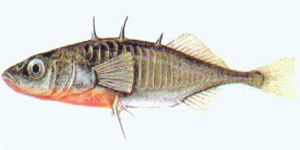

|

00 lbs |
00 oz |
04 drams |
00 kilos |
007 grams |
Year 1998 |
Distribution: Three-spined sticklebacks are the classic tiddler of British waters, and many other areas in the Northern Hemisphere.
The stickleback can be found in every type of water body from ditches to estuaries. It is one of the hardiest of fish, surviving in waters too polluted for other species.
Features:There are three distinct types of three spine stickleback. The leiurus form, the commonest freshwater stickleback, normally has between two and nine plates. The trachurus, or most heavily plated, form is essentially migratory. The semi-armatus form has a plate arrangement intermediate between the other two and is much less common.
During the spring the male develops its red spawning coloration around the throat and belly, together with bright blue eyes.
There are populations in marine and freshwater with some migrating between the two. They can actually sport two to four spines on their backs, with three being the average. These sharp spines and large bony side plates provide essential armour against an array of fish and bird predators.
Diet:
Their diet is varied and includes small mollusks, crustaceans and larval insects.
Spawning:The stickleback male is a fantastic father. After attracting an egg-laying female to a nest with a zig-zag courtship dance and bright red colourings, he fans the fertilised eggs with his fins to provide oxygen. Once the eggs have hatched he protects the small fry and teaches them self-defence from predators by chasing them. Spawning in rivers and passing the winters at sea.
Sticklebacks are the only British freshwater fish to build nests from vegetation and care for their young the first few weeks of life.
None of the sticklebacks are strong swimmers and they all tend to shun fast flowing waters.
©Norfolk Fishing Network 2004 - 2025®All Rights Reserved.